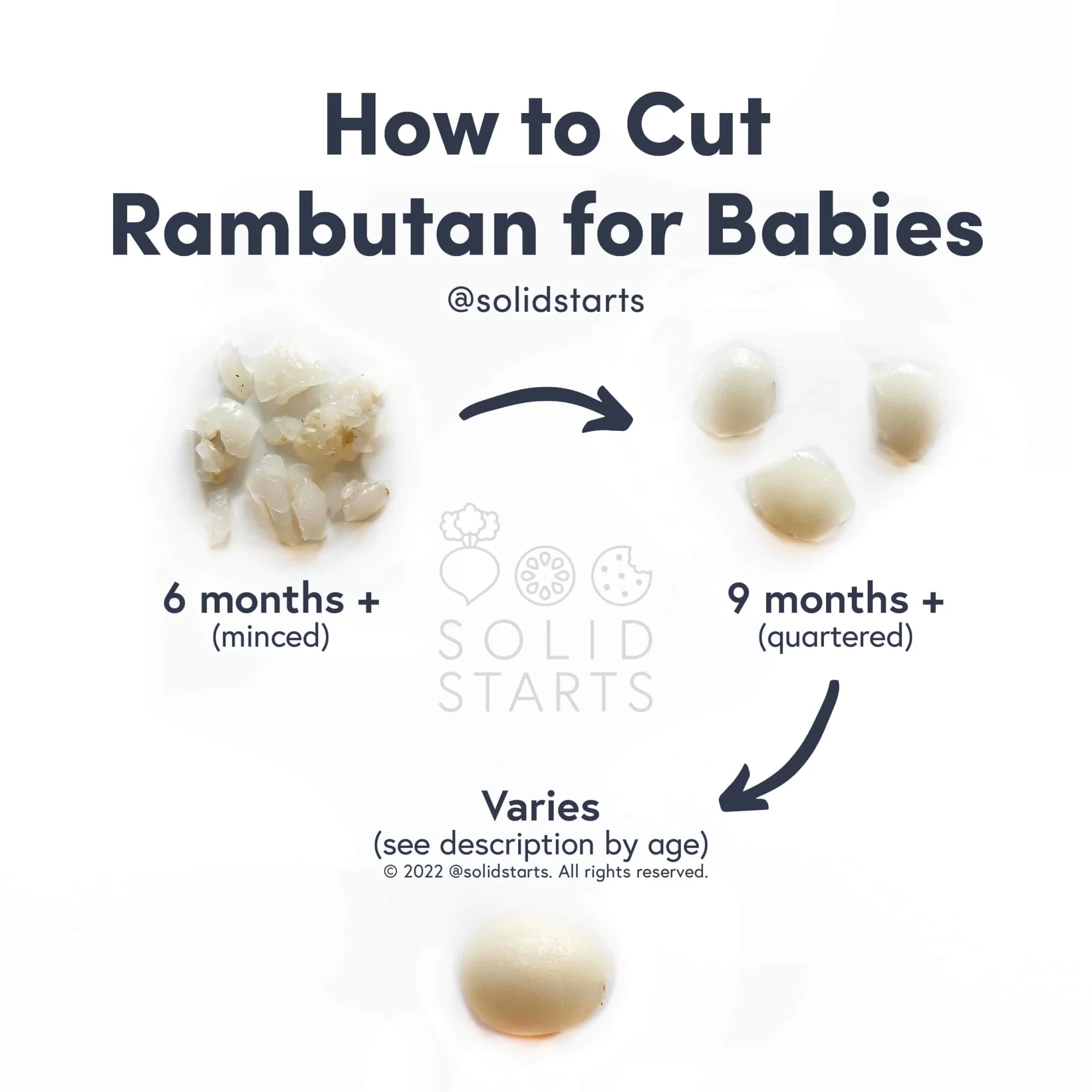Rambutan
Fruit
Age Suggestion
6 months
Iron-Rich
No
Common Allergen
No
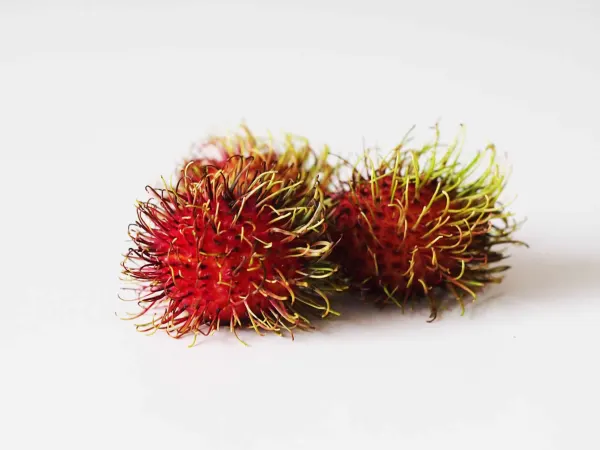
When can babies eat rambutan?
Rambutan may be introduced as soon as baby is ready to start solids, which is generally around 6 months of age. Both the flesh of the rambutan and the seed inside can be choking hazards, so take care to prepare rambutan in an age-appropriate manner before serving.
Where does rambutan come from?
Rambutan is the juicy fruit of an evergreen tree that originated in Southeast Asia and thrives wherever the weather is warm and wet like the tropics of the Americas, Africa, Asia, and the Pacific Islands, where the fruit is also known as chôm chôm, mak ngor, ngoh, and rambut. That last name, which means “hairy” in Malay, hints at rambutan’s appearance: the edible part of the fruit is protected by a thin, leathery casing that is covered with pliable spines.
Videos
Is rambutan healthy for babies?
Yes. Rambutan is packed with vitamin C, a powerful antioxidant that not only aids in the absorption of plant-based iron, but also supports baby’s skin and bone health. The high fiber content in this tropical fruit helps digestion by nourishing a baby’s developing gut microbiome. Rambutan also contains a fair amount of zinc and a dash of vitamin E—essential nutrients that help support baby’s immune system and much more.
Depending on where you live, canned rambutan may be more accessible than the fresh fruit, but the canned fruit is typically high in added sugars, making it not ideal for babies and young toddlers. Soak or rinse canned rambutan in water to reduce the sugar content, then cut according to baby’s age and eating ability.
Note that the seeds and peels of fresh rambutan, while consumed in certain cultures, can be toxic when regularly consumed in large amounts (according to animal studies), and are best avoided for baby. The seeds are also a choking risk and should be removed before serving.
Is rambutan a common choking hazard for babies?
Yes. You won’t find rambutan on most lists of the top choking hazards for babies, but the fruit’s chewy, firm, and slippery consistency poses a risk, as do the fruit’s seed and peel. To minimize the risk, remove the fruit from its peel, remove the inner seed, and cut the flesh into small pieces. As always, make sure you create a safe eating environment and stay within an arm’s reach of baby during meals. For more information on choking, visit our section on gagging and choking and familiarize yourself with the list of common choking hazards.
Is rambutan a common allergen?
No, rambutan is not a common allergen, but allergic reactions to rambutan have been reported. People who are allergic to pollens and individuals with Oral Allergy Syndrome (also known as pollen-food allergy) may be allergic to rambutan’s cousin, the lychee fruit, and possibly rambutan, by extension. Oral Allergy Syndrome typically results in short-lived itching, tingling, or burning in the mouth and is unlikely to result in a dangerous reaction. Fortunately, cooking the fruit can help minimize or even eliminate the reaction.
As you would when introducing any new food, start by offering a small quantity for the first few servings. If there is no adverse reaction, gradually increase the quantity over future meals.
Can rambutan help babies poop?
Yes. Rambutan is a good source of both insoluble and soluble fiber and polyphenols – together, they contribute to overall digestive health and bowel regularity. Note that pooping patterns can vary significantly from child to child. Be sure to talk to your pediatric healthcare provider if you have concerns about your baby’s pooping and digestive function.
What are recipe ideas for cooking with rambutan?
There are different varieties of rambutan, each with their own distinctive flavor, but most have a floral aroma and sweet and sour taste that is similar to pulasan and lychee, tropical fruits in the same family. Once removed from its spiny shell, the translucent egg-shaped fruit can be eaten fresh, pickled, preserved, or cooked in sweet desserts or savory curries, salads, salsas, and more. Try finely chopped or minced rambutan in savory and sweet warm cereals, coconut rice or quinoa, and chia puddings.
How do you prepare rambutan for babies with baby-led weaning?
Every baby develops on their own timeline, and the suggestions on how to cut or prepare particular foods are generalizations for a broad audience.
6 to 9 months old:
Finely chop fresh rambutan, seed and shell removed, and serve atop a soft, scoopable food like congee, mashed plantains, or yogurt. Refrain from offering processed rambutan products like jam, jelly, paste, or syrup at this age.
9 to 18 months old:
Discard the shell and cut open to remove the inner seed. Cut the pulp into quarters to create bite-sized pieces. Serve the pieces of rambutan on their own for the child to practice picking up or mix them into grains or fruit salads. Of course, you may continue to finely chop the pulp.
18 to 24 months old:
Continue to offer fresh rambutan that has been shelled, deseeded, and quartered or finely chopped. Encourage your child to chew well by modeling a dramatic chewing motion yourself. This is also a great age to introduce an age-appropriate fork, though keep in mind that eating with utensils can be exhausting for babies and toddlers, and many children toggle back and forth between feeding themselves with their fingers and utensils. Try not to apply too much pressure—consistent and accurate utensil use will come in due time, probably between 18 and 24 months of age.
36 months and up:
When you feel your child is ready and understands instructions, try working with whole rambutan that has been shelled, coaching how to take bites from the fruit around the seed. You can also coach the child to squish the fruit and pull the seed out with their fingers. Be sure to stay within an arm’s reach in case they need assistance.
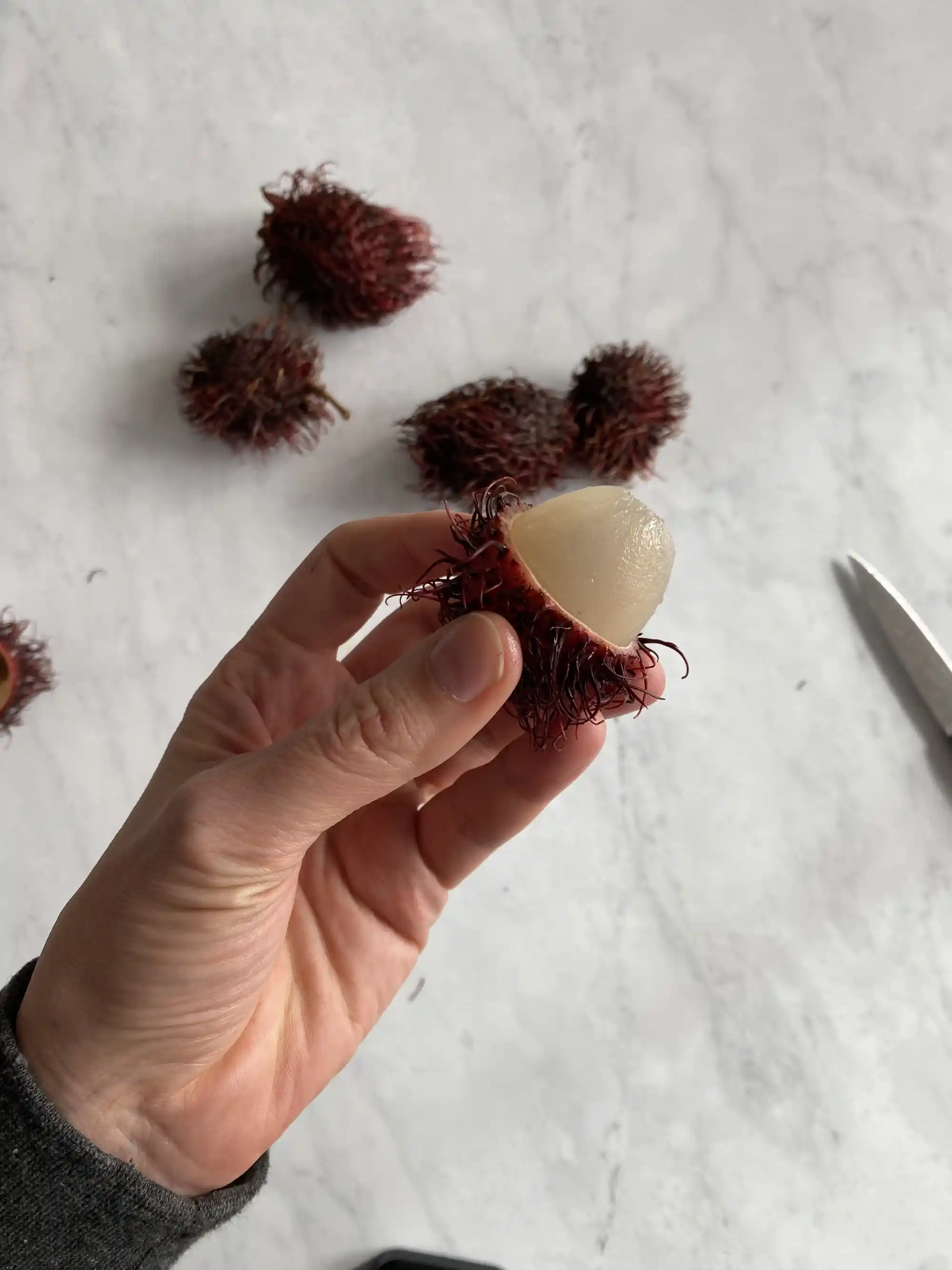
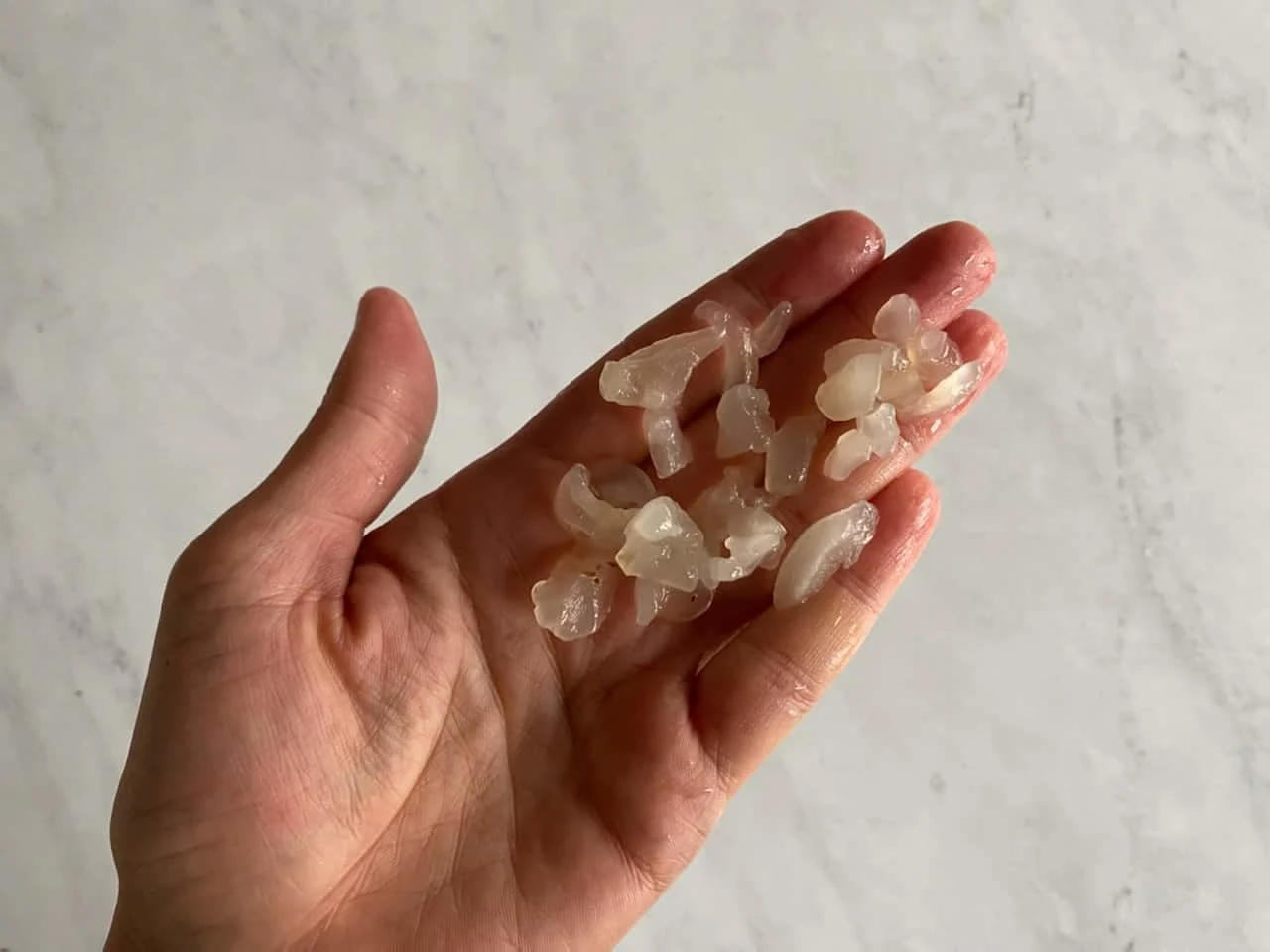
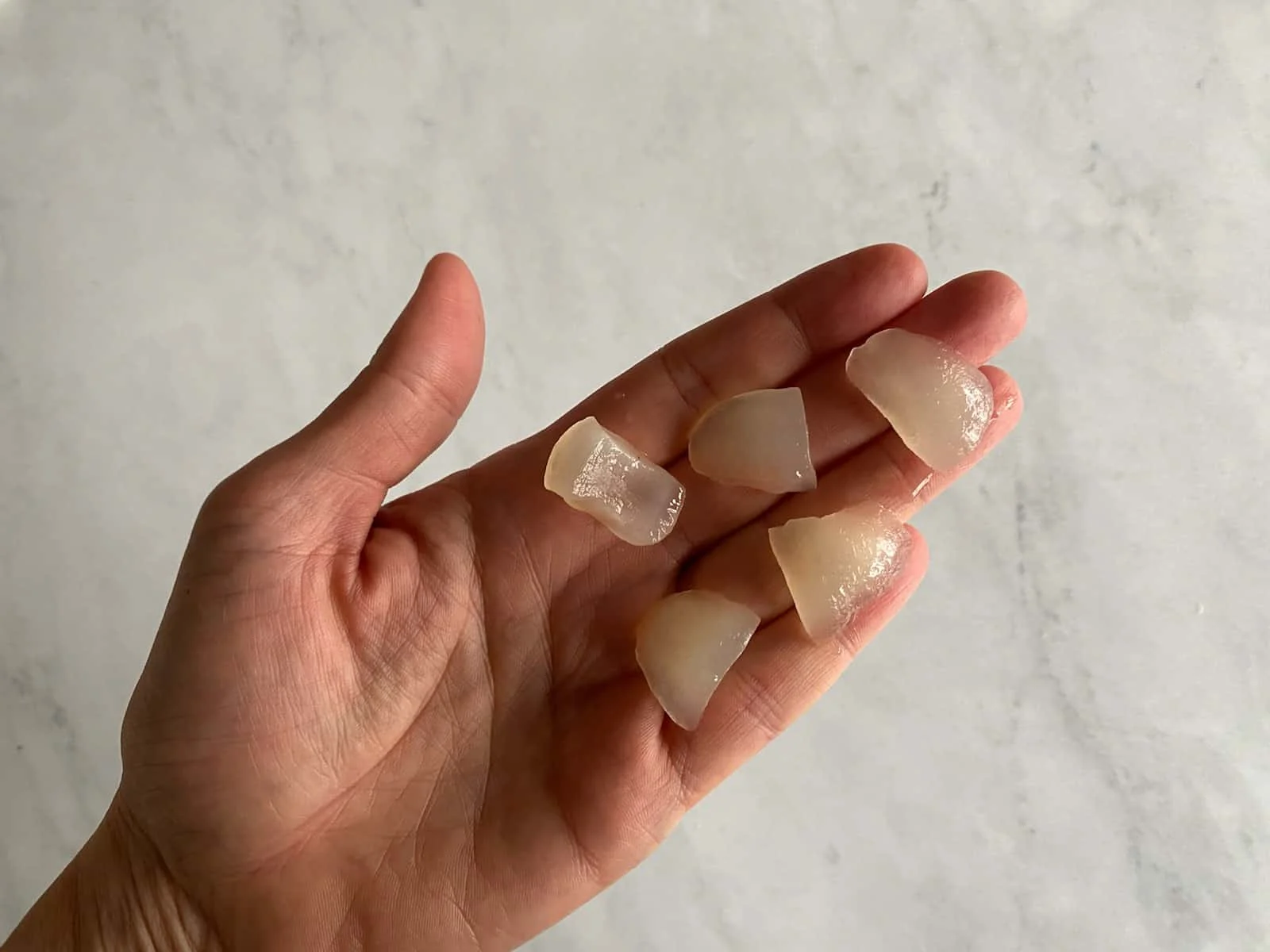
How to cut rambutan for babies
Read more about Sugar and Taste Preferences to help your child build a healthy relationship with sweet foods.
Written and reviewed by these specialists
J. Truppi, MSN, CNS
V. Kalami, MNSP, RD, CSP
K. Grenawitzke, OTD, OTR/L, SCFES, IBCLC, CNT
S. Bajowala, MD, FAAAAI. Board-Certified Allergist & Immunologist (allergy section)
R. Ruiz, MD, FAAP. Board-Certified General Pediatrician & Pediatric Gastroenterologist
Expert Tips Delivered to Your Inbox
Sign up for weekly tips, recipes and more!
Copyright © 2024 • Solid Starts Inc


